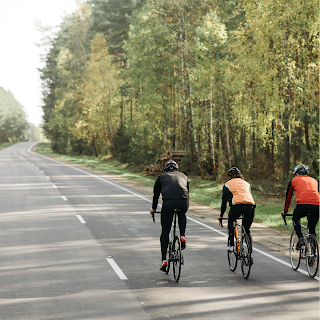The Bike Ride: A Guide to Planning Your Perfect Adventure

In this blog post, I will discuss everything you need to know to plan your perfect bike ride. We'll cover topics such as choosing the right bike, planning your route, packing your essentials, staying safe on the road, and more.
Choosing the Right Bike
The first step in planning your bike ride is to choose the right bike for your needs. If you're just starting out, you may want to consider a hybrid bike. Hybrid bikes are a good all-around bike that can be used for both road riding and off-road riding.
If you're planning on doing a lot of road riding, then you may want to consider a road bike. Road bikes are designed for speed and efficiency, and they're perfect for long-distance rides.
If you're planning on doing a lot of off-road riding, then you may want to consider a mountain bike. Mountain bikes are designed for handling rough terrain, and they're perfect for exploring trails and forests.
Planning Your Route
Once you've chosen the right bike, it's time to start planning your route. There are a few things to keep in mind when planning your route:
- The distance you want to ride. How far do you want to ride? If you're just starting out, you may want to start with a shorter ride and gradually increase the distance as you get more experience.
- The terrain you'll be riding on. If you're planning on riding on roads, then you'll need to make sure that your route is paved. If you're planning on riding off-road, then you'll need to make sure that your route is suitable for mountain bikes.
- The amenities along the route. Make sure that your route passes by places where you can stop for food, water, and restrooms.
- The time of day you'll be riding. If you're planning on riding in the morning or evening, you'll need to make sure that your route is well-lit.
- The weather forecast. You don't want to get caught in a storm.
Packing Your Essentials
Once you've planned your route, it's time to pack your essentials. Here are a few things you'll need to pack:
- A helmet. A helmet is essential for safety.
- Water. Make sure you pack enough water to stay hydrated.
- Food. Pack some snacks to keep your energy levels up.
- Repair kit. In case of a flat tire or other mechanical problem, you'll need a repair kit.
- Sunscreen. Protect yourself from the sun's harmful rays.
- Sunglasses. Protect your eyes from the sun and wind.
- First aid kit. Just in case.
- Cash or credit card. In case you need to stop for food or drinks.
Staying Safe on the Road
Here are a few tips for staying safe on the road:
- Obey the rules of the road. Just like cars, bikes have to obey the rules of the road. This includes things like stopping at red lights and yielding to pedestrians.
- Be predictable. Let drivers know what you're doing by signaling your turns and changes in direction.
- Be aware of your surroundings. Pay attention to what's going on around you so that you can avoid accidents.
- Use lights at night. Make sure you have lights on your bike so that drivers can see you at night.
- Be prepared for anything. Things can happen on the road, so be prepared for anything. This includes things like flat tires, mechanical problems, and bad weather.
Other Tips
- Start with a short ride. If you're not used to riding a bike, start with a short ride and gradually increase the distance as you get more comfortable.
- Listen to your body. If you're feeling tired or sore, take a break. Don't push yourself too hard.
- Have fun! Riding a bike is a great way to get exercise, enjoy the outdoors, and explore new places. So get out there and start planning your next adventure!
Bonus Tips
- Check the weather forecast before you go. You don't want to get caught in a storm.
- Let someone know where you're going and when you expect to be back. This is especially important if you're planning on riding a long distance or if you're riding in an unfamiliar area.
- Bring a map or GPS device. This will help you stay on track and avoid getting lost.
- Take breaks. Don't try to ride for too long without taking a break. This will help you avoid fatigue and injuries.
- Enjoy the scenery. Part of the fun of a bike ride is taking in the sights and sounds of your surroundings. So take your time and enjoy the journey.
Conclusion
Planning a bike ride can be a lot of fun. By following these tips, you can ensure that your bike ride is safe and enjoyable. So get out there and start planning your next adventure!
Here are some additional tips for planning a bike ride:
- Use a bike route planner. There are a number of online tools that can help you plan a bike route. These tools can take into account factors such as the distance you want to ride, the terrain you'll be riding on, and the amenities along the route.
- Ride with a friend or group. Riding with a friend or group can make your bike ride more enjoyable and safer.
- Join a bike club. There are many bike clubs that offer group rides, social events, and other activities. Joining a bike club is a great way to meet new people and learn more about cycling.
- Get involved in local cycling events. There are many local cycling events that take place throughout the year. These events are a great way to meet other cyclists, challenge yourself, and have fun.


Comments
Post a Comment